|
CHICKAMAUGA and CHATTANOOGA National Military Park |
 |
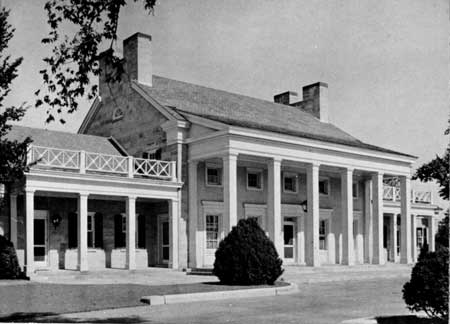
Park Administration and Museum Building.
Guide to the Area
CHICKAMAUGA BATTLEFIELD. A self-guided tour of the battlefield may be made by automobile. This 8-mile tour begins at park headquarters and follows the yellow line on the tour road. On the gravel roads a yellow arrow points the way. Red markers indicate Confederate forces and blue markers show Union forces. As you read the markers or sight along the barrel of a field gun, you face the direction the troops moved at the time of the battle. There are several monuments of spherical, iron shells along the tour. Of these, the low square monuments mark the sites of various army and corps headquarters; the taller, triangular shaped monuments designate the sites where eight brigade commanders were killed during the battle.
The numbered sections in the following guide correspond to location numbers on the map.
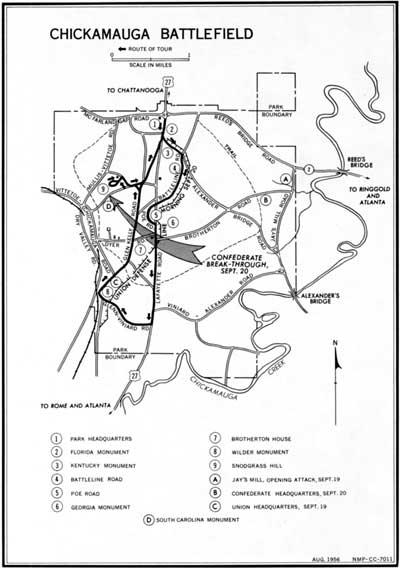
(click on map for an enlargement in a new window)
1. Park Headquarters. It is suggested that before making the tour of the Chickamauga Battlefield, you stop first at park headquarters located on U. S. 27, where an attendant is on duty. Exhibits there describe the battle, and the Fuller Gun Collection is displayed.
The Claud E. and Zenada O. Fuller Collection of American Military Arms contains almost every type of shoulder arms used by the military forces of America. There are several rare or unique items in the collection. The Harpers Ferry Blunderbuss, manufactured in 1808, and the Texas Rifle (1844) are the only ones known to exist. The Jenks Rifle, the pattern for the model 1840 Musket, the pattern for the model 1817 Rifle, and the Sharps, with coffeemill in the stock, are extremely rare. The Confederate section, while not complete, contains some outstanding weapons.
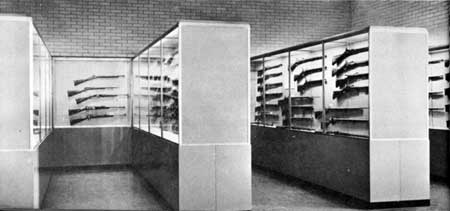
Part of Fuller Gun Collection, Park Headquarters and Museum
Building, Chickamauga Battlefield.
2. Florida Monument. Immediately after leaving park headquarters, you will see the Florida Monument to your left on U. S. 27.
3. Kentucky Monument. Bear to the left at this monument.
4. Battleline Road. Make a right turn to enter Battleline Road. The positions of the Confederate right wing are on the left in the wooded area some 75 to 250 yards east of the road. Union troops occupied the line along the road during the second day of the battle.
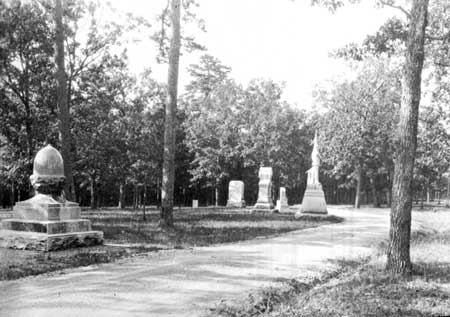
Union monuments along Battleline Road, Chickamauga Battlefield.
5. Poe Road. Cross U. 5. 27 and follow Poe Road. This route is a continuation of the Union defense line that you have followed along Battleline Road. You will note in this area that several Confederate batteries are so situated that it would appear they must have fired into their own infantry. This situation resulted from Longstreet's breakthrough. The Confederate troops in this sector turned right after crossing the highway and struck the right center of the Union line. A careful examination of the metal markers at each battery will give the movements of each unit and the time element involved.
A metal marker designates the site of the Poe House.
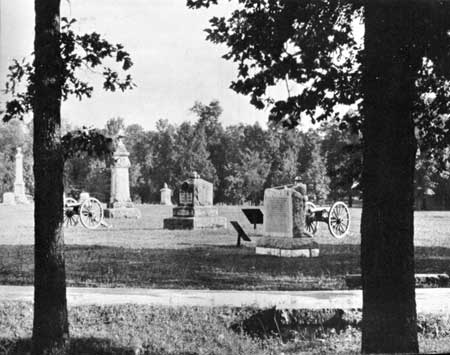
Union monuments at Viniard Field, Chickamauga Battlefield.
6. Georgia Monument. This imposing shaft is directly in front of you as you leave Poe Road to enter the main highway. Upon entering the main highway turn right.
7. Brotherton House. (Please face the house). This reconstructed house marks the site of the old Brotherton home, famous for the Confederate breakthrough. Here Longstreet found the gap in the Union lines (to the rear of the house at the wooded area) and sent his troops forward. The Confederate troops emerged from the wooded area back of you, crossed the LaFayette Road, and drove westward and northward. This action was the turning point in the Battle of Chickamauga.
The monument of shell across the highway in back of you marks Maj. Gen. Simon Bolivar Buckner's headquarters site.
After leaving the Brotherton House, you continue for 1.1 miles and make a right turn. The triangular shell monument on the right along the highway commemorates Col. Hans C. Heg (Union).
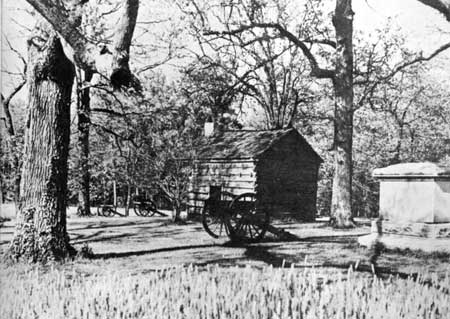
Brotherton House, scene of Confederate breakthrough, Chickamauga
Battlefield.
Courtesy Chattanoogans, Inc.
8. Wilder Monument. This imposing monument was authorized in 1892 and completed in 1902, to honor Col. John T. Wilder and his troops. It is built of Chickamauga limestone and rises to a height of 86 feet. A spiral staircase leads to a platform at the top where you can obtain an excellent view of the battlefield and surrounding area.
Wilder's troops occupied the ground in this vicinity when Longstreet sent the left wing of the Confederate Army forward. This brigade of mounted infantry was armed with the Spencer repeating carbine, a seven-shot weapon. These troops, numbering more than 2,000 men, poured a deadly fire into Longstreet's veterans, but were unable to stop the Confederate advance. They remained on the field until the last minute and had to fight to get to their horses.
The monument stands upon the ground where General Rosecrans had his headquarters on the 19th and early morning of the 20th of September 1863.
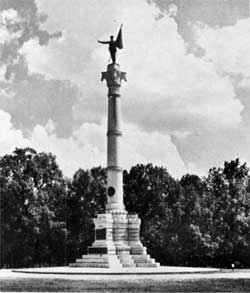 Georgia Monument, Chickamauga Battlefield. |
 Wilder Monument, Chickamauga Battlefield. |
9. Snodgrass Hill. The log cabin on Snodgrass Hill marks the home of the Snodgrass family.
The troops from the center of the Union line began to fall back toward this hill when Longstreet's men rushed through the gap in the Union line. Brannan's Division and fragments of Negley's, Wood's, and Van Cleve's Divisions held the positions on the hill. About 2 p. m. Steedman's Division arrived to reinforce the line on the extreme right. The Union troops held the hill during the afternoon and at dusk began the withdrawal that led them through McFarland's Gap and into Rossville.
The tour ends on Snodgrass Hill. To return to park headquarters and U. S., 27, please follow park headquarters signs and the yellow lines.
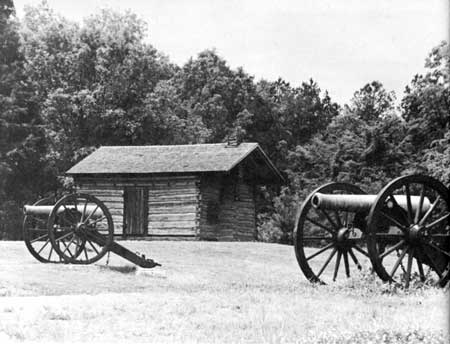
Snodgrass House, Chickamauga Battlefield.
Courtesy Walter H. Miller.

|

|
|
Last Modified: Fri, May 17 2002 10:00:00 pm PDT |


